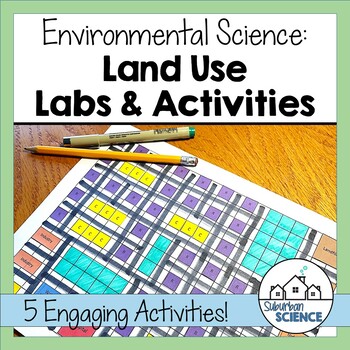Human Impact on Environment Activities: Land Use, Urbanization, & Sustainability
- Zip
What educators are saying
Also included in
- Looking for hands-on labs and activities for a high school Environmental Science course? This bundle contains 63 thorough and engaging projects, indoor and outdoor labs, activities, and experiments for hands-on learning! The environmental labs and activities included in this bundle are designed toPrice $120.00Original Price $153.50Save $33.50
Description
This is an engaging bundle of environmental science activities on land use and urbanization. Students will learn about urban planning, heat islands, the history of urbanization, impacts of cities & climate change. Human impacts on the environment are interwoven throughout these lessons to provide students with a good basis for any environmental science or APES course. This activity set is the perfect addition to a sustainability unit in a high school Environmental Science course. Teacher pages, student pages, rubrics, and answer keys are all included and ready to use!
➤Please note: This is also part of my Land Use & Sustainability Unit and Full Environmental Science Curriculum.
Product includes:
1. Be a City Planner Activity - Students will use smart growth strategies to plan and organize a new city
- 1 teacher instruction page
- 2 student instruction pages
- 2 city design resource sheets
- Topics: industry/commerce, green space, mass transit, power generation, community, landscape, city planning
2. Heat Islands Activity - Students explore a Google Earth website to learn more about heat islands in Japan
- Answer key
- 1 student page
- Topics: heat island effect
3. Impacts of Urbanization - Students work with a group of students to research environmental impacts of urbanization and create a poster to share their findings
- 2 student instruction pages
- Grading rubric
- Topics: noise and light pollution, habitat fragmentation, runoff, importation of resources, air and water pollution
4. Sprawl - Students visit interactive maps and answer questions to learn more about sprawl
- Answer key
- 3 student pages
- Topics: urban sprawl (ribbon, leapfrog, low-density radial), land reclamation, smart growth, zoning, green space
5. Urban Issues in Developing and Developed Countries - Students explore issues related to urbanization in both developing and developed countries and consider those issues' impacts
- 2 student pages
- Topics: wealth distribution birth/mortality rates, industrialization rates
*For more details and visuals of the lesson, click on the PREVIEW link above.*
➤Where can I find other Environmental Science Activity Bundles?
- Intro to Env Sci Activities
- Ecology & Symbiosis Activities
- Species & Population Growth Activities
- Biomes & Biodiversity Activities
- Plate Tectonics Activities
- Soil Erosion & Soil Conservation Labs & Activities
- Mining Impacts Labs & Activities
- Fossil Fuels & Renewable Energy Activities
- Freshwater Labs & Activities
- Marine and Fishing Labs & Activities
- Water Quality & Water Pollution Labs & Activities
- Land Use & Urbanization Activities
- Sustainable Agriculture Activities
- Sustainable Forestry Activities
➤Looking for other Environmental resources? Save $$ on these great bundles, too:
- Environmental Science Data Analysis & Critical Thinking Extension Pages
- Environmental Science PowerPoint Bundle
- Environmental Science Cornell Notes Bundle- match with PPT bundle (above)
- Environmental Science Doodle Notes Bundle
- Environmental Science Webquest Bundle
_______________________________________________________________
⭐For updates about sales and new products, please follow my store: My TpT Store
You can also
⭐Subscribe to my newsletter for freebies and teaching tips
⭐Follow me on Instagram
⭐Check out my Facebook page
⭐Follow me on Pinterest
I value your feedback. Please rate this product. If you have any issues or questions about this product, please feel free to ask a question in my store or write to me at support@suburbanscience.com.






